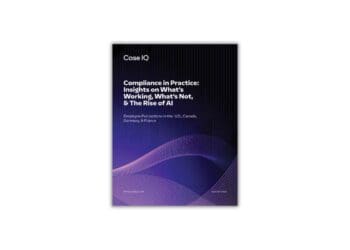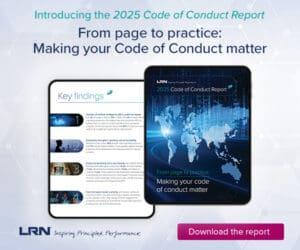Pay: It’s not always the most comfortable conversation to have, but for companies that are serious about achieving a discrimination-free workplace, ensuring pay equity is a good place to start. Employment attorney Heather Bussing discusses the finer points of starting (and repeating) a pay equity audit.
Never miss a compliance opportunity to make a better workplace. After all, it’s compliance. It’s not like it’s optional. You have to do it. Compliance with employment laws is fundamentally about doing the work to create a discrimination- and harassment-free workplace where people are treated with dignity and paid fairly based on their work. This seems like a good thing.
Instead of treating compliance as some burdensome requirement that interferes with business, use it as an opportunity. Having a discrimination- and harassment-free workplace helps attract and retain the right people so that you can provide quality products and services for your clients. It’s much better than spending time with lawyers in depositions and courtrooms. And a lot less expensive, too.
Start with pay equity
Start with pay equity because it’s easier than most other initiatives. Pay equity falls somewhere between pretty easy, like tracking overtime and calculating final paychecks, and really difficult, like creating a discrimination- and harassment-free workplace.
Pay equity is fundamentally math and statistics. It’s about figuring out whether people doing comparable work are paid differently for that work and whether there is a statistical correlation between pay differences and gender or race. When dealing with pay equity, you don’t have to convince anyone that they are doing something wrong and should change beliefs they may not even know they have. You just have to do a pay equity audit so you can see the issues and address them. And you can address them with money, which is also easier than organizing and getting people to show up for unconscious bias training. (Although you may not be able to get out of that one, depending on which state you’re in.)
Pay equity is not just a good idea; it’s the law
The fact that it is easier to detect and address gender and racial pay gaps than other forms of discrimination is partly why legislators are passing new pay equity laws. Almost half of states in the U.S. have salary history bans and/or pay transparency laws either on the books or in process, and more are considering them every year.
Three states — California, Illinois, and Massachusetts — require pay data reporting along with jobs and demographics, and the EEOC is planning on reviving pay data reporting.
The other reason legislators are passing new pay equity laws is that we have not made any progress toward eliminating pay equity in the past 30 years. Even more optimistic timelines show that we won’t have overall pay equity until 2088, and that’s based on making the kind of progress we did in the 1960s, which is not happening today. In short, pay equity has been federal law for over 60 years, and it’s not working. So, it’s time to do something different.
Colorado, Oregon and Massachusetts have established safe harbors. The idea is to encourage organizations to identify pay gaps and fix them instead of simply punishing those who don’t. Safe harbors laws exempt organizations from liability for pay gaps for a period of time if they regularly audit for pay equity, have created a plan to address pay gaps and are making progress on that plan.
We are going to see more pay equity safe harbor laws. In the meantime, the right course of action is to act like you have a safe harbor and take the steps to identify and address pay equity.
Data Privacy Laws Protect Consumers, But They Can Apply to Your Employees, Too
States increasingly enacting laws covering employee data
Read moreDetailsAddressing pay gaps
When you find pay gaps based on gender or race — and you will because every organization has them — you can only address them by raising pay. It is illegal to reduce someone’s pay to achieve pay equality. This makes sense. First, the people making more presumably deserve it, are doing a good job and you want to keep them. Second, they should not bear the burden of the employer’s pay gaps elsewhere; the employer should. Third, raising the pay of people who are underpaid because of their gender or race is what actually solves the problem.
Raising pay requires budget. This is the good news and bad news. The bad news is that it’s always hard to get budget. The good news is getting money is still easier than changing people. The key is to know going into your pay equity audit that there will be issues that require some people to get raises. And when you give some people raises but not others, the others will want raises, too. This can be handled through communications and transparency about what’s going on. But only if you manage it from the start.
Here’s what you need:
- Leadership commitment. Doing a pay equity audit involves having leadership’s commitment to achieving pay equity, not just finding out if there are issues. It also means prioritizing pay equity as a must-have compliance issue.
- Budget. Pay equity analysis involves budgeting for the time and resources to gather the data to do the analysis, potentially buying new software to organize the data, doing the math and statistics, exploring options for addressing pay gaps and giving people raises who should have them.
- Communications. People are sensitive about pay for lots of reasons and in many different ways. Pay equity is part of a larger story about compensation philosophy, why people make what they make and how compensation works in the organization. If the organization is clear on these things, communications about pay equity should be fairly straightforward. If not, then pay equity initiatives can uncover more complex issues, both practical and legal. Get clear on what you are up against and how to navigate it before you start implementing pay audit tools. Once you are in the audit and remediation process, you’ll need communications to help people understand what is happening and why and that it’s about building a fairer workplace for everyone.
- Continued monitoring. Establish a regular cadence for pay equity audits to avoid surprises and stay compliant. Quarterly is good unless there are significant changes like layoffs, mergers or substantial increases in hiring or voluntary turnover. (When your voluntary turnover jumps, you likely have bigger problems than not having enough people to do the work.) Pay equity is dynamic and shifts slightly any time someone comes or goes. Use your data and tools regularly to account for this.
The great news is that the problems you find won’t be that bad. It won’t be everyone, and if you have any kind of compensation structure and use reasonable pay ranges, you will be able to close the gaps with a reasonable amount of money in a reasonable amount of time. The EEOC’s notable pay equity litigation often involved a few thousand dollars per affected employee to bring their annual pay into line.
Addressing pay equity in your organization is one of the best ways to reduce risk, get ahead of compliance issues and create an organization where people are paid fairly. And that is a fine start toward creating a discrimination- and harassment-free workplace (which is also both federal and state law).




 Heather Bussing is a California employment attorney, writer and law professor. Quoted in The New York Times, Wall Street Journal, CNN, Business Insider and NPR, she writes a daily column for Salary.com’s “Compensation and Pay Equity” newsletter on the latest in employment laws, covering pay equity and transparency, AI in HR Tech and why compliance, diversity and fairness are good business.
Heather Bussing is a California employment attorney, writer and law professor. Quoted in The New York Times, Wall Street Journal, CNN, Business Insider and NPR, she writes a daily column for Salary.com’s “Compensation and Pay Equity” newsletter on the latest in employment laws, covering pay equity and transparency, AI in HR Tech and why compliance, diversity and fairness are good business. 








